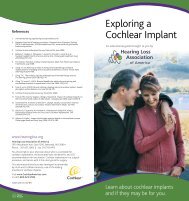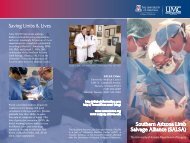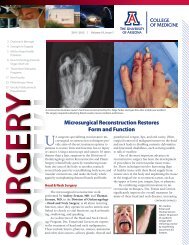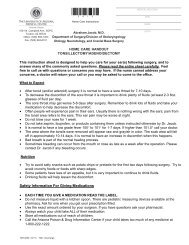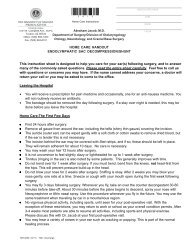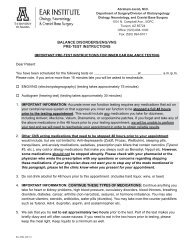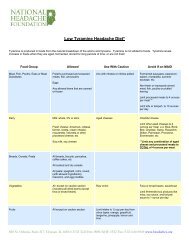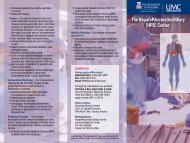Hugo Villar, MD - Department of Surgery - University of Arizona
Hugo Villar, MD - Department of Surgery - University of Arizona
Hugo Villar, MD - Department of Surgery - University of Arizona
Create successful ePaper yourself
Turn your PDF publications into a flip-book with our unique Google optimized e-Paper software.
inside…<br />
2 Chairman’s<br />
Message<br />
2 Examining<br />
Quality-<strong>of</strong>-Life<br />
Decisions<br />
3 Bionic Bladder<br />
Device<br />
4 Varicose Veins<br />
Vanish<br />
4 Torn Aorta<br />
Repaired<br />
5 New Neurosurgery<br />
PA Program<br />
6 Alumni Spotlight<br />
– Henry Flores, <strong>MD</strong><br />
6 <strong>Department</strong> News<br />
7 Faculty Awards &<br />
Publications<br />
The <strong>Department</strong> <strong>of</strong><br />
<strong>Surgery</strong> at The <strong>University</strong><br />
<strong>of</strong> <strong>Arizona</strong> College <strong>of</strong><br />
Medicine is renowned<br />
for its research, patient<br />
care and academic<br />
achievement. The<br />
department features<br />
specialized sections<br />
in cardiovascular and<br />
thoracic surgery, surgical<br />
research, general surgery<br />
and trauma, surgical<br />
oncology, neurosurgery,<br />
plastic surgery, ENT,<br />
transplantation, urology<br />
and vascular surgery.<br />
Abdominal Transplant<br />
Program Performing<br />
Well After Hiatus<br />
Liver – Putting the Pieces Together<br />
The UA <strong>Department</strong> <strong>of</strong> <strong>Surgery</strong>’s Abdominal<br />
Transplant Program is moving full speed ahead<br />
since getting a boost last summer with the hiring<br />
<strong>of</strong> distinguished transplant<br />
surgeon Ernesto P. Molmenti,<br />
<strong>MD</strong>, PhD, MBA, who was<br />
recruited from Johns Hopkins<br />
<strong>University</strong> School <strong>of</strong> Medicine.<br />
Between 1992 and<br />
2002, <strong>University</strong> Medical<br />
Center conducted 170 liver<br />
transplants but inactivated<br />
its transplant program in<br />
2002 when it lost its liver surgeon. Last summer,<br />
the United Network <strong>of</strong> Organ Sharing (UNOS)<br />
approved the continuation <strong>of</strong> the UMC pediatric<br />
and adult Liver Transplant Program with the hiring<br />
<strong>of</strong> Dr. Molmenti, says <strong>Hugo</strong> <strong>Villar</strong>, <strong>MD</strong>, interim<br />
head <strong>of</strong> the UA <strong>Department</strong> <strong>of</strong> <strong>Surgery</strong>.<br />
Since his arrival last June, Dr. Molmenti,<br />
pr<strong>of</strong>essor <strong>of</strong> surgery and chief <strong>of</strong> abdominal<br />
transplantation, has pulled together<br />
a multidisciplinary team focused on<br />
providing comprehensive care for<br />
abdominal transplant patients.<br />
The first liver transplant since the<br />
program’s reactivation was performed in<br />
February on a Tucson man. UMC’s firstever<br />
split-liver transplant was<br />
performed in July on a 6-monthold<br />
girl and a 51-year-old man,<br />
both suffering from end-stage<br />
liver failure. Each received new<br />
livers when surgeons divided<br />
a single liver from a deceased<br />
donor and transplanted<br />
portions <strong>of</strong> it into each<br />
patient in back-to-back<br />
surgeries.<br />
Liver transplantation is<br />
a life-saving treatment for<br />
a variety <strong>of</strong> irreversible<br />
acute and chronic liver diseases<br />
for which no other therapy is available.<br />
at the <strong>Arizona</strong> Health Sciences Center<br />
Spring/Summer 2006<br />
Volume 5, Issue 2<br />
Kidney – Pediatric Program Added<br />
For the past several years, UMC has focused<br />
almost exclusively on adult kidney transplant under<br />
the leadership <strong>of</strong> kidney transplant surgeon, John<br />
D. Hughes, <strong>MD</strong>. Since taking over the program, Dr.<br />
Molmenti has been transplanting kidneys at a record<br />
pace in partnership with nephrologist Sam James, <strong>MD</strong>,<br />
medical director <strong>of</strong> UMC’s kidney transplant program.<br />
And the addition <strong>of</strong> a new pediatric nephrologists,<br />
Mona Zawaideh, <strong>MD</strong>, allows UMC once again to <strong>of</strong>fer<br />
kidney transplant to children.<br />
“It’s wonderful that we now have an active<br />
pediatric transplant program again,” said Dr.<br />
Zawaideh, the only doctor in the nation who is boardcertified<br />
in pediatric nephrology and board-eligible in<br />
pediatric endocrinology. “We are looking forward to<br />
helping many children with serious kidney problems,”<br />
she says.<br />
Pancreas – New Hope for Diabetics<br />
The first pancreas transplant since the hospital’s<br />
revival <strong>of</strong> its abdominal transplant program was<br />
performed by Dr. Molmenti on a 46-year-old Tucson<br />
mother suffering from type 1 diabetes. The operation<br />
allows her to be insulin free, and also prevents the<br />
progression, and even partially reverses many <strong>of</strong> the<br />
complications associated with diabetes.<br />
Kidney and pancreas transplants can eliminate<br />
both end-stage renal disease and type 1 diabetes<br />
in some patients. While medication is able to<br />
control the blood sugars <strong>of</strong> most patients<br />
diagnosed with diabetes, it cannot decrease<br />
the rate <strong>of</strong> secondary complications, which<br />
can include amputation, heart problems,<br />
and even death.<br />
“Type 1 diabetes occurs because<br />
your pancreas produces little or<br />
CoNTiNUED oN PAgE 3<br />
According to the United Network for<br />
organ Sharing (UNoS), more than<br />
90,000 Americans are on the waiting<br />
list for an<br />
in <strong>Arizona</strong>,<br />
patients on waiting<br />
lists for:<br />
kidney 862<br />
liver 305<br />
pancreas 21<br />
heart 65<br />
lung 8<br />
Illustration: Dave Cantrell<br />
AHSC Biomedical Communications<br />
organ<br />
transplant.
2<br />
Chairman’s Message<br />
As I reflect on the 05/06 academic year<br />
for the <strong>Department</strong> <strong>of</strong> <strong>Surgery</strong>, I believe<br />
that overall, it has been a success. Below<br />
are just a few <strong>of</strong> the highlights.<br />
Our Abdominal Transplant Program<br />
is growing at a steady and safe pace.<br />
The kidney transplant program, previously<br />
under the able stewardship <strong>of</strong> Dr.<br />
John Hughes, has been taken over by Dr.<br />
Ernesto Molmenti, who performed more<br />
than 70 kidney transplants last year. Three<br />
liver transplants also have been successfully<br />
performed, the last being a split-liver<br />
transplant into a 6-month-old infant with<br />
a metabolic disease <strong>of</strong> the liver, and an<br />
adult recipient. The commitment <strong>of</strong> UMC<br />
to our transplantation program has been<br />
second to none. Staff education and training<br />
have been a major component <strong>of</strong> our<br />
success. I feel blessed being able to assist<br />
Dr. Molmenti in harvesting and implanting<br />
all these livers.<br />
Dr. Susan Parker, a colorectal surgeon,<br />
will be joining us in early January 2007<br />
from St. Paul, Minn., where she works at<br />
one <strong>of</strong> the largest colorectal groups in the<br />
country. Her expertise in pelvic disorders<br />
and colorectal issues will be a major asset<br />
to our department. Our goal is to develop<br />
a pelvic disorder center with Urology.<br />
The Tuba City rural rotation for the<br />
General <strong>Surgery</strong> Residency Program<br />
continues to be a success. The experience <strong>of</strong><br />
our residents has been extremely favorable.<br />
Dr. Julie Lindholm will replace Dr. Greg<br />
Jarrin as our surgical coordinator. Dr.<br />
Jarrin was one <strong>of</strong> the main pillars <strong>of</strong> this<br />
rotation when we first started in 2003 and<br />
he will be greatly missed. Dr. Jarrin has<br />
relocated to Winslow.<br />
The Section <strong>of</strong> Cardiothoracic <strong>Surgery</strong><br />
has hired Dr. Kimberly Gandy, a pediatric<br />
heart surgeon and Dr. Shari Meyerson for<br />
the thoracic program. With the addition <strong>of</strong><br />
Dr. Kay Goshima, the Section <strong>of</strong> Vascular<br />
<strong>Surgery</strong> now has four fellowship-trained<br />
surgeons and they expect to incorporate<br />
UPH-Kino Hospital as an extra site for<br />
their clinical activities, including the<br />
development <strong>of</strong> a vascular laboratory.<br />
Trauma continues to be very busy as the<br />
only Level I<br />
Trauma Center<br />
in Southern<br />
<strong>Arizona</strong>.<br />
UPH-Kino<br />
Hospital has been a successful addition<br />
to our surgical education activities. We<br />
now have a second-year and a fourthyear<br />
resident rotating there and the volume<br />
steadily has increased to an average<br />
<strong>of</strong> 40-45 surgical cases per month. The<br />
tireless efforts <strong>of</strong> Drs. Amy Waer and<br />
Jennifer Tittensor are greatly appreciated<br />
in the development <strong>of</strong> the surgical<br />
service that has fulfilled the goal <strong>of</strong><br />
UPH-Kino being an educational opportunity<br />
for our residents. Dr. Gerlinde<br />
Tynan has replaced Dr. Tittensor who<br />
has moved to Utah for family reasons.<br />
A trained laparoscopic surgeon is anticipated<br />
to join us at Kino in late 2006.<br />
This past year we saw a revitalization<br />
<strong>of</strong> the <strong>Department</strong> finances. We<br />
finished this fiscal year with a rewarding<br />
positive margin. The increased<br />
efforts <strong>of</strong> our faculty, residents and staff<br />
have allowed us to overcome our deficit.<br />
We have been able to provide almost<br />
$700,000 in incentives to our clinical<br />
faculty, a tribute to their efforts and<br />
commitment to patient care.<br />
In summary, the <strong>Department</strong> continues<br />
to move forward in a positive direction.<br />
The incorporation <strong>of</strong> UPH-Kino<br />
and Tuba City as important educational<br />
sites has been a major accomplishment.<br />
The resident match was successful as<br />
it has been in the past. All our chief<br />
residents successfully have passed their<br />
board exams and obtained employment<br />
or fellowship positions. The <strong>Department</strong>’s<br />
finances are in the black, and we<br />
all look forward to the completion <strong>of</strong> our<br />
<strong>Department</strong>’s chairman search.<br />
Sincerely,<br />
<strong>Hugo</strong> V. <strong>Villar</strong>, <strong>MD</strong><br />
Pr<strong>of</strong>essor and Interim Head,<br />
UA <strong>Department</strong> <strong>of</strong> <strong>Surgery</strong><br />
Cutting-Edge Research<br />
Research Examines Quali<br />
With new innovations in cancer<br />
treatments, quality <strong>of</strong> life is an<br />
important consideration for patients and<br />
their families when making healthcare<br />
decisions, whether their disease can be cured<br />
or they are facing the end <strong>of</strong> life.<br />
Surgeons in particular face unique<br />
challenges when it comes to palliative, or<br />
end-<strong>of</strong>-life care. For example, they have<br />
to weigh the risks and side-effects <strong>of</strong> the<br />
operation on an incurable disease with the<br />
potential relief <strong>of</strong> symptoms.<br />
As a member <strong>of</strong> the American College <strong>of</strong><br />
Surgeons Palliative Care Task Force Executive<br />
Committee, Robert Krouse, <strong>MD</strong>, associate<br />
pr<strong>of</strong>essor, Section <strong>of</strong> Surgical Oncology, in the<br />
UA <strong>Department</strong> <strong>of</strong> <strong>Surgery</strong>, and oncologic<br />
surgeon at the Southern <strong>Arizona</strong> Veterans<br />
Affairs Health Care System (SAVAHCS),<br />
has been a leader in establishing guidelines<br />
and promoting excellence in the practice <strong>of</strong><br />
end-<strong>of</strong>-life care. Dr. Krouse is part <strong>of</strong> two<br />
proposed research studies looking at ways<br />
to help patients and practitioners deal with<br />
difficult quality-<strong>of</strong>-life decisions.<br />
Model <strong>of</strong> Support<br />
One study, in conjunction with the City<br />
<strong>of</strong> Hope National Medical Center, is testing<br />
an innovative model for patients undergoing<br />
palliative surgery.<br />
“The role <strong>of</strong> surgery in palliative care is<br />
to control pain, nausea and other symptoms<br />
when no other options exist to cure the<br />
disease,” explains Dr. Krouse. The Quality<br />
<strong>of</strong> Life Intervention (PS-QOLI) model<br />
uses a scoring system when considering<br />
interventions for patients whose disease is<br />
not responding to treatment and who are<br />
nearing the end <strong>of</strong> life. The model looks at<br />
symptoms, risks and quality-<strong>of</strong>-life concerns<br />
for the patients and their families and helps<br />
establish realistic goals for both the patient<br />
and the physician.<br />
“A variety <strong>of</strong> factors influence the<br />
way patients make decisions about their<br />
treatment,” Dr. Krouse says. “The patient’s<br />
culture, age, stage <strong>of</strong> illness and emotional<br />
status all contribute to their decision making<br />
and we are looking at how these factors<br />
influence palliative surgical care.”<br />
The UA <strong>Department</strong> <strong>of</strong> <strong>Surgery</strong> and<br />
SAVAHCS will be the control sites <strong>of</strong> the
ty-<strong>of</strong>-Life Decisions<br />
study that compares outcomes <strong>of</strong> using<br />
the PS-QOLI model vs. current standard-<br />
care procedures.<br />
Lifestyle Changes for Survivors<br />
Surviving cancer is a success story. But<br />
sometimes the treatment <strong>of</strong> the cancer<br />
causes a long-term lifestyle change that<br />
impacts the survivor’s quality <strong>of</strong> life.<br />
A previous research project funded by<br />
a grant from the National Cancer Institute<br />
focused on the quality-<strong>of</strong>-life issues <strong>of</strong><br />
long-term colorectal cancer survivors with<br />
intestinal stomas, or ostomies. An ostomy<br />
is a surgical opening on the abdomen for<br />
the release <strong>of</strong> stool. This procedure is used<br />
when the bowel is removed, partially<br />
removed, or does not function normally<br />
due to the treatment <strong>of</strong> the cancer.<br />
The study examined the impact on the<br />
health-related quality <strong>of</strong> life and optimal<br />
functioning for patients with ostomies<br />
years past their treatment. It then brought<br />
participants who were either doing very<br />
well or those who had persistent problems<br />
together to discuss their continued concerns<br />
and barriers, how they were coping, and<br />
what they would recommend to others<br />
with stomas.<br />
The primary goal <strong>of</strong> a new follow-up<br />
study proposal is to test the feasibility <strong>of</strong><br />
a Chronic Care Ostomy Self-Management<br />
Program that ostomy patients and their<br />
doctors follow from the pre-operative stage<br />
to post-surgical lifestyle management.<br />
“Managing the long-term effects can<br />
be life altering for patients and there are<br />
no pre-operative decision-support aids<br />
to guide patients and their families in<br />
understanding what is involved,” Dr.<br />
Krouse says.<br />
The follow-up study,<br />
which would<br />
be conducted<br />
in the VA<br />
system, uses<br />
a prescribed<br />
series <strong>of</strong><br />
training<br />
sessions for<br />
ostomates<br />
designed<br />
to help<br />
Tiny, Wireless Device<br />
Studied for overactive<br />
Bladder<br />
Urologists at the UA <strong>Department</strong> <strong>of</strong> <strong>Surgery</strong><br />
are investigating a tiny, wireless bionic device<br />
designed to treat one <strong>of</strong> the most disconcerting and<br />
disabling disorders: incontinence.<br />
Approximately 30 million Americans suffer from urinary frequency or urge<br />
incontinence. Urge incontinence is associated with a strong desire to urinate with little<br />
warning or time to reach a bathroom. “People who suffer from this disorder may have to<br />
urinate dozens <strong>of</strong> times a day, <strong>of</strong>ten causing them to rarely leave their homes,” says Craig<br />
Comiter, <strong>MD</strong>, chief, Section <strong>of</strong> Urology, and principal investigator for the study. “Current<br />
non-surgical treatments for urinary incontinence include medication and diet control, but<br />
are only effective in about half <strong>of</strong> the cases,” he says.<br />
Surgical options include traditional neurostimulators, which act as bladder “pacemakers,”<br />
delivering an electrical impulse to a nearby nerve to relieve the sudden and sometimes<br />
uncontrollable urge to urinate. Implantation <strong>of</strong> these devices involves a one to two week<br />
test <strong>of</strong> a temporary externalized wire attached to a battery operated pulse generator worn<br />
on the belt. Definitive surgical implantation involves placement <strong>of</strong> a battery-powered pulse<br />
generator, which may result in a prominent bulge under the patient’s skin.<br />
The UA is the only site in <strong>Arizona</strong> participating in a multi-center clinical trial to<br />
evaluate a new miniature device about the size <strong>of</strong> a matchstick. The bion microstimulator,<br />
manufactured by Advanced Bionics Corp, is designed to treat urgency, urinary frequency<br />
and urge incontinence through direct electrical stimulation. The small size <strong>of</strong> the device<br />
(less than 1 inch long and ¼ inch wide) allows for sutureless implantation, leaving no<br />
visible scar.<br />
The microstimulator bion is implanted under the skin near the pelvis and adjacent to<br />
the pudenal nerve, the nerve near the tailbone that influences bladder control muscles. The<br />
battery-operated device uses a small amount <strong>of</strong> electrical current to stimulate the nerve,<br />
increasing urine capacity in patients with overactive bladders that have not responded to<br />
other treatments.<br />
The clinical trail is a one-year study <strong>of</strong> 20 patients. There is no cost to patients who<br />
qualify for the trial. For more information about this study, contact Cameo Kjose, research<br />
specialist, at (520) 626-0033. l<br />
them adjust to their ostomies. The proposed<br />
study includes several evaluation tools to<br />
determine the effectiveness <strong>of</strong> the training<br />
sessions, and involves the assistance<br />
<strong>of</strong> experienced ostomates to help new<br />
ostomates with their adjustment. It also<br />
addresses the importance <strong>of</strong> a support<br />
framework for the ostomates by involving<br />
their spouses or significant others in part <strong>of</strong><br />
the training sessions.<br />
“Researchers and clinicians increasingly<br />
are recognizing the importance <strong>of</strong><br />
examining the role <strong>of</strong> surgery in quality<strong>of</strong>-life<br />
care. These studies will provide a<br />
framework that will help patients, their<br />
families and their physicians in making<br />
decisions about surgical intervention,”<br />
Dr. Krouse says. l<br />
Transplant Program CoNT. FRoM PAgE 1<br />
no insulin. A pancreas transplant is a<br />
successful treatment option for people who<br />
have advanced type 1 diabetes or who<br />
don’t respond well to standard insulin<br />
treatments,” says Dr. Molmenti.<br />
Comprehensive Service<br />
UMC is the only transplant center in<br />
<strong>Arizona</strong>, Nevada and New Mexico <strong>of</strong>fering<br />
liver transplants to children. It is also the<br />
only hospital in Southern <strong>Arizona</strong> and one<br />
<strong>of</strong> only three hospitals in the state that <strong>of</strong>fer<br />
full abdominal transplants – liver, kidney<br />
and pancreas.<br />
“Our ultimate goal is to prolong a<br />
person’s life while improving the quality <strong>of</strong><br />
it,” says Dr. <strong>Villar</strong>. l
Quality Patient Care<br />
Varicose Veins Vanish<br />
with New Treatment<br />
Varicose vein sufferers can now show <strong>of</strong>f<br />
their legs. UA surgeons are performing<br />
a minimally invasive procedure that removes<br />
varicose veins with little to no pain, bruising,<br />
or swelling.<br />
Varicose veins develop when the valves<br />
that usually keep blood flowing out <strong>of</strong> the<br />
legs become damaged or diseased. Normally<br />
veins carry blood from the extremities<br />
toward the heart. With varicose veins, the<br />
blood pools in the legs causing the veins to<br />
distend. In addition to the unattractive skin<br />
discoloration and bulging, some people may<br />
have swelling or pain in the legs, itching,<br />
soreness or aching.<br />
The primary treatment alternative is<br />
to re-route blood flow through healthy<br />
veins. Traditionally, this has been done<br />
by surgically removing (stripping) the<br />
troublesome vein from the leg. This involved<br />
manually pulling out the saphenous vein.<br />
Patients suffered a lengthy and painful<br />
recovery period.<br />
The newer procedure delivers<br />
radi<strong>of</strong>requency energy to the vein wall,<br />
causing it to collapse and seal shut. Patients<br />
In May, doctors at UMC repaired the<br />
partially torn aorta <strong>of</strong> an 81-year-old<br />
Tucson man, who had been injured in a car<br />
accident, without open-chest surgery.<br />
A majority <strong>of</strong> patients with a torn aorta<br />
bleed to death before they reach a trauma<br />
center, but fortunately for this patient,<br />
bleeding from the<br />
small tear in his aorta<br />
was contained in the<br />
tissues, forming a<br />
“pseudo-aneurysm”<br />
at very high risk <strong>of</strong><br />
rupture.<br />
The traditional<br />
treatment for aorta<br />
repair is to open the<br />
chest, put the heart on<br />
a heart-lung machine<br />
see results right away<br />
and the recovery is much<br />
shorter.<br />
First a thin catheter is<br />
inserted into the damaged<br />
vein through a small incision.<br />
Using ultrasound guidance,<br />
the catheter is manipulated up<br />
the vein, and radi<strong>of</strong>requency<br />
energy is delivered to the vein<br />
wall, causing it to heat, collapse and<br />
seal shut. Once the diseased vein is<br />
closed, healthy veins take over, and normal<br />
blood flow returns to the leg, allowing the<br />
swelling and discoloration to improve.<br />
“Those with traditional vein stripping<br />
would be on bed rest for one to two weeks<br />
with heavy bandages to prevent swelling,<br />
pain and bruising. With the new procedure<br />
patients go home the same day and are<br />
typically back at work in a few days,” says<br />
assistant pr<strong>of</strong>essor Daniel M. Ihnat, <strong>MD</strong>,<br />
a vascular surgeon in the UA <strong>Department</strong><br />
<strong>of</strong> <strong>Surgery</strong>.<br />
“Patients have reported feeling little, if<br />
any, pain during the procedure and there is<br />
basically no recovery period. Most patients<br />
resume normal activity very rapidly,” Dr.<br />
Ihnat says. “Patients who had suffered<br />
painful symptoms <strong>of</strong> varicose veins report<br />
Torn Aorta Trauma Repaired without open Heart <strong>Surgery</strong><br />
W.L. Gore & Associates, Inc.<br />
and sew up the tear. “It’s major surgery<br />
that we hate to inflict on a patient who<br />
is critically injured already, but we do it<br />
because it saves lives,” says cardiac surgeon<br />
Raj K. Bose, <strong>MD</strong>, assistant pr<strong>of</strong>essor in the<br />
UA <strong>Department</strong> <strong>of</strong> <strong>Surgery</strong>.<br />
Instead, the trauma team stabilized the<br />
patient while surgeons sought out a new<br />
device approved by the Food and Drug<br />
Administration just last year to repair<br />
thoracic aortic aneurysm on an elective basis.<br />
A few days after the car accident,<br />
interventional radiologist Gary J. Becker,<br />
<strong>MD</strong>, and Dr. Bose inserted a catheter into<br />
the patient’s femoral artery through a 2-inch<br />
incision in the groin. Using X-ray imaging<br />
to check their progress, they snaked the<br />
catheter about 2 feet through the artery to<br />
the aorta. There, they deployed a GoreTex<br />
noticeable improvement in one to two weeks<br />
following the procedure.<br />
“People mistakenly think that treating<br />
varicose veins is cosmetic, but many<br />
patients are very unhappy due to the pain<br />
and discomfort,” says Joseph Mills, <strong>MD</strong>,<br />
pr<strong>of</strong>essor and section chief <strong>of</strong> vascular<br />
surgery at the UA. “Many don’t realize it’s a<br />
medical problem and that treatment usually<br />
is covered by insurance.”<br />
Varicose veins are caused by a number<br />
<strong>of</strong> things including prolonged standing,<br />
heredity, obesity and pregnancy. Some 41<br />
percent <strong>of</strong> American women may have<br />
varicose vein disease by the time they reach<br />
their 40s and 50s. l<br />
“endograft,” or stent, 4<br />
inches long and slightly<br />
more than 1 inch in<br />
diameter that covered the<br />
hole in the aorta, removing<br />
any further threat <strong>of</strong><br />
hemorrhage.<br />
Drs. Becker, Bose and Raj K. Bose, <strong>MD</strong><br />
Joseph Mills, <strong>MD</strong>, chief <strong>of</strong> vascular surgery,<br />
performed UMC’s first minimally invasive<br />
thoracic aortic aneurysm repair using the<br />
same type <strong>of</strong> endograft earlier this spring.<br />
However, use <strong>of</strong> an endografting<br />
procedure to repair a life-threatening aortic<br />
injury is a first for UMC, said Dr. Becker.<br />
“This is a new weapon in our trauma<br />
arsenal that is going to directly benefit the<br />
people <strong>of</strong> Southern <strong>Arizona</strong>,” he says. l
Innovative Education<br />
Virtual <strong>Surgery</strong><br />
for Realistic Training<br />
The <strong>Arizona</strong> Simulation Technology<br />
and Education Center (ASTEC) in<br />
the UA College <strong>of</strong> Medicine now <strong>of</strong>fers a<br />
new opportunity for laparoscopic surgery<br />
training with a virtual-reality trainer.<br />
Like pilots using flight simulators,<br />
medical simulators allow surgeons to<br />
learn and acquire new skills without<br />
risk to human life. Actual laparoscopic<br />
instruments interact with the images <strong>of</strong><br />
anatomies created from real patients,<br />
providing the most realistic surgical<br />
simulation training available.<br />
To schedule a training or tour, call<br />
Alyson Knapp at 626-8585. l<br />
Practice makes perfect – UA medical student<br />
performs virtual surgery using ASTEC’s new simulator.<br />
UA Neurosurgery’s<br />
Postgraduate PA<br />
Program First in U.S.<br />
The Association <strong>of</strong> Postgraduate<br />
Physician Assistant Programs has<br />
approved the nation’s first Physician<br />
Assistant (PA) postgraduate residency<br />
program in neurological surgery at the<br />
UA <strong>Department</strong> <strong>of</strong> <strong>Surgery</strong>.<br />
The one-year residency provides<br />
an opportunity for a PA actively to be<br />
involved in the care <strong>of</strong> neurological<br />
surgery patients through extensive clinical<br />
education in the operative and nonoperative<br />
management <strong>of</strong> neurosurgical<br />
disease. “We modeled the program based<br />
on the UA Neurosurgery Residency<br />
Program. This gives all Neurosurgery<br />
residents – <strong>MD</strong>s and PAs – the same<br />
clinical and didactic experiences,” says<br />
Martin Weinand, <strong>MD</strong>, pr<strong>of</strong>essor and<br />
graduating Residents/incoming interns<br />
General <strong>Surgery</strong><br />
The UA <strong>Department</strong> <strong>of</strong> <strong>Surgery</strong> has ended another academic year with six graduating<br />
general surgery chief residents: Elizabeth Butler, <strong>MD</strong>, has begun a cardiothoracic<br />
fellowship in Milwaukee; Cris Barrios, <strong>MD</strong>, has been accepted to a trauma fellowship<br />
in Irvine, Calif.; Kent Stevens, <strong>MD</strong>, is working with former UA faculty member, Steve<br />
Johnson, <strong>MD</strong>, in the trauma/critical care fellowship at Shock Trauma in Baltimore;<br />
Shawn Stevenson, DO, has entered private practice in general surgery with Agave<br />
Surgical Association in Tucson; Gerlinde Tynan, <strong>MD</strong>, is serving on the faculty<br />
at <strong>University</strong> Physicians Healthcare Hospital at Kino Campus for a year prior to beginning<br />
a vascular surgery fellowship at Northwestern <strong>University</strong> in Chicago; and Eleazar Ley, <strong>MD</strong>,<br />
has begun a crani<strong>of</strong>acial surgery fellowship in Utah.<br />
New Residents<br />
Categorical Atanu Biswas East Tennessee State <strong>University</strong><br />
Evan Glazer George Washington <strong>University</strong><br />
Erika Hernandez <strong>University</strong> <strong>of</strong> Texas at San Antonio<br />
Brian Madigan Ohio State <strong>University</strong><br />
Zack Taylor Michigan State <strong>University</strong><br />
Hannah Zimmerman <strong>University</strong> <strong>of</strong> Missouri-Kansas City<br />
Preliminary Mark Robinson Ohio State <strong>University</strong> Anesthesiology 2007<br />
in <strong>Surgery</strong> Tracy Ansay The <strong>University</strong> <strong>of</strong> <strong>Arizona</strong> Neurosurgery 2007<br />
Michelle Byrne Midwestern <strong>University</strong> Anesthesiology 2007<br />
Eric Cornidez Stanford <strong>University</strong> Anesthesiology 2007<br />
Chris Dillon The <strong>University</strong> <strong>of</strong> <strong>Arizona</strong> Radiology 2007<br />
Urology David Ritsema Vanderbilt <strong>University</strong><br />
Preliminary<br />
Cardiovascular and Thoracic <strong>Surgery</strong><br />
Griffin Coates, <strong>MD</strong>, graduated from the UA <strong>Department</strong> <strong>of</strong> <strong>Surgery</strong> Section <strong>of</strong><br />
Cardiovascular and Thoracic <strong>Surgery</strong> Residency Program and has accepted a faculty<br />
position in the <strong>Department</strong>. He primarily will be practicing at Tucson Medical Center.<br />
Joining the CT Residency Program is Orazio Amabile, <strong>MD</strong>, who completed his general<br />
surgery residency at Maricopa Medical Center in Phoenix.<br />
Urology<br />
Also graduated in 2006 were urology residents Todd Purves, <strong>MD</strong>, and Duan Copeland,<br />
<strong>MD</strong>. Dr. Purves has been accepted to a pediatric fellowship at Johns Hopkins <strong>University</strong>,<br />
and Dr. Copeland is in private practice in Pinetop-Lakeside, Ariz. l<br />
Section <strong>of</strong> Neurosurgery chief. The UA<br />
<strong>Department</strong> <strong>of</strong> <strong>Surgery</strong> performs more than<br />
1,500 neurosurgical operations per year,<br />
including trauma.<br />
“We could be like every other<br />
neurosurgery department and add another<br />
clinical PA position,” Dr. Weinand said.<br />
“But we realize PAs are more than physician<br />
extenders and providing this training<br />
will help us attract those to our service<br />
who want to be trained and maintain an<br />
academic focus.”<br />
M. Salome Phillips, PA-C, is the<br />
program’s first neurosurgery PA resident.<br />
Before the UA program was established,<br />
she completed a neuroscience residency in<br />
New York, but she says she still needed more<br />
training to specialize in neurosurgery.<br />
“I think the surgical side <strong>of</strong> PAs is<br />
underutilized, especially in the West,” says<br />
Dave Howard, RN, PA-C, the program<br />
director. “As we see a move toward<br />
accreditation for everything, this program<br />
gives PAs the backing <strong>of</strong> training evaluated<br />
by a neurological panel.”<br />
For more information on the UA<br />
<strong>Department</strong>. <strong>of</strong> <strong>Surgery</strong> PA Neurosurgery<br />
Residency Training Program, contact<br />
Julie Schippers, program coordinator, at<br />
(520) 626-2164. l<br />
5
6<br />
Innovative Education<br />
Alumni Spotlight<br />
Greetings<br />
from<br />
Wine Country<br />
Henry C. Flores, <strong>MD</strong><br />
Class <strong>of</strong> ’99<br />
After completing<br />
the residency in<br />
general surgery in 1999, I had the good<br />
fortune to return to a job in California’s<br />
Sonoma County. I have an <strong>of</strong>fice in a small<br />
town called Healdsburg where there also<br />
is a small community hospital. I also<br />
work at two hospitals in Santa Rosa, one<br />
being a Level II trauma center. I primarily<br />
perform bread-and-butter surgery, as<br />
well as advanced laparoscopy. My wife,<br />
Colleen, and I have three children: Alex, 14,<br />
Nicholas, 11, and Maggie, 7.<br />
I recruited David Hardin, <strong>MD</strong>, who<br />
completed the program in general surgery<br />
in 2003 to join me in Healdsburg. He<br />
has been a great asset to our surgical<br />
community. He also works in Santa Rosa.<br />
Dave and Michele welcomed the birth<br />
<strong>of</strong> their son, Matthew, who turned 1 in<br />
August.<br />
Healdsburg is in the heart <strong>of</strong> the wine<br />
country with a population <strong>of</strong> approx<br />
11,000. It is a community <strong>of</strong> rolling hills and<br />
valleys which are well known worldwide<br />
for making great wines. The attraction<br />
<strong>of</strong> the wines in Healdsburg has brought<br />
many great restaurants to the area as well.<br />
It is a short drive from San Francisco,<br />
approximately 65 miles. The Pacific Coast<br />
is just 30 miles away.<br />
We have enjoyed the slow-paced<br />
lifestyle here in Healdsburg. If anyone<br />
has any interest in visiting Healdsburg or<br />
Sonoma County, please do not hesitate to<br />
contact either Dave Hardin or me. We can<br />
share a bottle <strong>of</strong> wine. l<br />
We Need<br />
Your Support<br />
New Faculty<br />
What’s Up in <strong>Surgery</strong>?<br />
Anthony Admire,<br />
<strong>MD</strong>, returns to<br />
the UA College <strong>of</strong><br />
Medicine as assistant<br />
pr<strong>of</strong>essor <strong>of</strong> clinical<br />
surgery in the Section<br />
<strong>of</strong> Plastic <strong>Surgery</strong><br />
after completing a<br />
coordinated general<br />
surgery/plastic surgery residency at<br />
St. Louis <strong>University</strong>. Dr. Admire received<br />
both his bachelor <strong>of</strong> science and medical<br />
degrees from The <strong>University</strong> <strong>of</strong> <strong>Arizona</strong>.<br />
He is a candidate member <strong>of</strong> the American<br />
Society <strong>of</strong> Plastic Surgeons and advisor to<br />
the <strong>Arizona</strong> Medical Board.<br />
Shari Meyerson,<br />
<strong>MD</strong>, is assistant<br />
pr<strong>of</strong>essor <strong>of</strong> surgery<br />
in the Section <strong>of</strong><br />
Cardiovascular and<br />
Thoracic <strong>Surgery</strong>. Dr.<br />
Meyerson comes to<br />
the UA from Duke<br />
<strong>University</strong> Medical<br />
Center where she completed a thoracic<br />
surgery residency. Prior to that she trained<br />
in general surgery at the <strong>University</strong> <strong>of</strong><br />
Chicago Hospitals. She received her<br />
medical degree from the <strong>University</strong> <strong>of</strong><br />
Chicago Pritzker School <strong>of</strong> Medicine. Her<br />
<strong>Surgery</strong> research aims to develop new treatments and find new cures. Surgical education<br />
strives to improve patient care. gifts play a crucial role in funding these programs in the UA<br />
<strong>Department</strong> <strong>of</strong> <strong>Surgery</strong>. grateful patients, family members and alumni can donate money on<br />
behalf <strong>of</strong> the outstanding surgical care or training they have received at The <strong>University</strong> <strong>of</strong><br />
<strong>Arizona</strong>. Your support will help us reach our goals and advance the field <strong>of</strong> surgery.<br />
Programs you can support (naming opportunities available):<br />
Research<br />
Palliative Care<br />
Early Detection <strong>of</strong> Lung Cancer<br />
ECMo – extracorporeal membrane<br />
oxygenation (heart-lung device)<br />
program<br />
practice will focus on non-cardiac thoracic<br />
surgery with a special interest in minimally<br />
invasive approaches to lung cancer as well<br />
as esophageal surgery.<br />
Gerlinde Tynan,<br />
<strong>MD</strong>, transitions from<br />
UA General <strong>Surgery</strong><br />
Residency Program<br />
to assistant pr<strong>of</strong>essor<br />
<strong>of</strong> clinical surgery in<br />
the Section <strong>of</strong> General<br />
<strong>Surgery</strong>. Dr. Tynan<br />
completed her medical<br />
degree at <strong>University</strong> <strong>of</strong> Washington<br />
School <strong>of</strong> Medicine and is a member <strong>of</strong> the<br />
American College <strong>of</strong> Surgeons.<br />
Kaoru (Kay)<br />
Goshima, <strong>MD</strong>, is<br />
assistant pr<strong>of</strong>essor <strong>of</strong><br />
clinical surgery in the<br />
Section <strong>of</strong> Vascular<br />
<strong>Surgery</strong>. She has<br />
completed residencies<br />
in Vascular <strong>Surgery</strong><br />
and General <strong>Surgery</strong><br />
at the UA. Dr. Goshima completed her<br />
medical degree at St. Louis <strong>University</strong>. She<br />
received the Exceptional Resident Teaching<br />
Award during her general surgery<br />
residency, and is a member <strong>of</strong> the American<br />
College <strong>of</strong> Surgeons. l<br />
Education<br />
grand Rounds Visiting<br />
Pr<strong>of</strong>essor Lectures<br />
Resident Fellowships<br />
Student Scholarships<br />
Contact:<br />
Jo Marie gellerman<br />
UA <strong>Department</strong> <strong>of</strong> <strong>Surgery</strong><br />
(520) 626-7219<br />
jgellerm@email.arizona.edu
<strong>Hugo</strong> <strong>Villar</strong>, <strong>MD</strong>, Named<br />
Distinguished Latin American<br />
Surgeon 2007<br />
<strong>Hugo</strong> <strong>Villar</strong>, <strong>MD</strong>, pr<strong>of</strong>essor and<br />
interim chairman, UA <strong>Department</strong><br />
<strong>of</strong> <strong>Surgery</strong>, was named the Distinguished<br />
Latin American Surgeon in the United<br />
States for 2007 by the Federation <strong>of</strong> Latin<br />
American Surgeons (FELAC - Federacion<br />
Latino Americana de Cirugia). FELAC’s<br />
mission is to advance the promotion<br />
and improvement <strong>of</strong> the investigation,<br />
education and practice <strong>of</strong> surgery.<br />
Every two years, FELAC selects an<br />
American surgeon with Latin American<br />
roots who has distinguished him or herself<br />
in the U.S. and has worked to advance<br />
the practice <strong>of</strong> surgery in Latin America.<br />
Dr. <strong>Villar</strong> was honored for his leadership<br />
in surgical education in Latin America.<br />
Among his many achievements, Dr. <strong>Villar</strong><br />
recently helped develop and implement<br />
the American Society <strong>of</strong> Clinical Oncology<br />
(ASCO) Multidisciplinary Cancer<br />
Management Course in Latin America,<br />
whose purpose is to train physicians in<br />
developing countries on a multidisciplinary<br />
approach to cancer care. Courses in 2006<br />
have been held in the Dominican Republic,<br />
Peru, Panama and Chile.<br />
In addition, as the coordinator <strong>of</strong> the<br />
Latin American Chapters <strong>of</strong> the American<br />
College <strong>of</strong> Surgeons (ACS), Dr. <strong>Villar</strong><br />
directs each year the half-day program on<br />
Latin American surgical education at the<br />
ACS annual clinical congress meeting. l<br />
Awards & Recognition<br />
Best Doctors<br />
Six UA <strong>Department</strong> <strong>of</strong> <strong>Surgery</strong> faculty<br />
members are listed as 2006 Best Doctors in<br />
America:<br />
Neurological Allan J. Hamilton, <strong>MD</strong><br />
<strong>Surgery</strong><br />
<strong>Surgery</strong> Michael J. Demeure. <strong>MD</strong><br />
Joseph L. Mills, Sr., <strong>MD</strong><br />
Surgical Oncology <strong>Hugo</strong> <strong>Villar</strong>, <strong>MD</strong><br />
Thoracic <strong>Surgery</strong> Jack G. Copeland, <strong>MD</strong><br />
Urology Sanjay Ramakumar, <strong>MD</strong><br />
Heart <strong>Surgery</strong>, Neurosurgery and<br />
Urology Move Up in Rankings in<br />
U.S.News & World Report<br />
Three surgical subspecialties at<br />
<strong>University</strong> Medical Center moved up in the<br />
rankings among the top 50<br />
hospitals in the nation,<br />
according to U.S.News<br />
& World Report’s annual<br />
guide to “America’s Best<br />
Hospitals.” Heart <strong>Surgery</strong><br />
moved up to 16 th place in 2006<br />
from 22 nd in 2005; Neurosurgery climbed to<br />
22 nd from 33 rd in 2005; and Urology rose to<br />
27 th from last year’s 46 th rank.<br />
Michael J. Demeure, <strong>MD</strong>, pr<strong>of</strong>essor,<br />
Section <strong>of</strong> General <strong>Surgery</strong>, is the local<br />
host and organizer for the Adrenocortical<br />
Cancer Symposia in collaboration with<br />
TGen October 20 in Phoenix. He also is the<br />
local host for the American Association <strong>of</strong><br />
Endocrine Surgeons meeting April 29-May<br />
1, 2007.<br />
Joseph L. Mills, Sr., <strong>MD</strong>, pr<strong>of</strong>essor and<br />
chief, Section <strong>of</strong> Vascular and Endovascular<br />
<strong>Surgery</strong>, was elected president <strong>of</strong> the<br />
Association <strong>of</strong> Program Directors in<br />
Vascular <strong>Surgery</strong> (APDVS) at the APDVS<br />
annual meeting in April in Washington,<br />
D.C. He also became the vice chair <strong>of</strong> the<br />
Fellow’s Council <strong>of</strong> the Society <strong>of</strong> Vascular<br />
<strong>Surgery</strong> (SVS) at the Annual SVS meeting in<br />
Philadelphia in June 2006.<br />
<strong>Hugo</strong> <strong>Villar</strong>, <strong>MD</strong>, pr<strong>of</strong>essor and interim<br />
chairman, received the Best Physician award<br />
by the <strong>University</strong> Medical Center Board.<br />
Amy L. Waer, <strong>MD</strong>, assistant pr<strong>of</strong>essor<br />
<strong>of</strong> clinical surgery; chief, Section <strong>of</strong> General<br />
<strong>Surgery</strong>; and chief <strong>of</strong> surgery, <strong>University</strong><br />
Physicians Healthcare Hospital at Kino,<br />
has been elected president <strong>of</strong> the Tucson<br />
Surgical Society Association.<br />
Martin E. Weinand, <strong>MD</strong>, was elected to<br />
membership in the Society <strong>of</strong> Neurological<br />
Surgeons.<br />
Christina Kim, <strong>MD</strong>, assistant pr<strong>of</strong>essor <strong>of</strong><br />
surgery, Section <strong>of</strong> Surgical Oncology, and<br />
<strong>Arizona</strong> Gov. Janet Napolitano – During a visit<br />
to the <strong>Arizona</strong> Health Sciences Center in March,<br />
gov. Napolitano was presented an overview <strong>of</strong> the<br />
High-Risk Clinic for Breast and ovarian Cancers<br />
and a current clinical trial to detect breast cancer<br />
cells in their earliest stages.<br />
John M. Porter, <strong>MD</strong>, pr<strong>of</strong>essor <strong>of</strong> clinical<br />
surgery; chief, Section <strong>of</strong> Trauma and Critical<br />
Care; and <strong>Department</strong> <strong>of</strong> <strong>Surgery</strong> vice chairman,<br />
was the speaker at the UA College <strong>of</strong> Medicine<br />
Convocation at Centennial Hall in May.<br />
Poker, Golf Tournaments Benefit UMC Trauma<br />
Tucsonans teed <strong>of</strong>f and anted up to support <strong>University</strong> Medical Center’s Level 1 Trauma Center.<br />
Since the first golf tournament fundraiser in 2003, almost $100,000 has been raised for the program.<br />
This year two fund-raising events, the inaugural Golden Hour Gamble May 19 and the annual<br />
Cecil Family Golden Hour Golf Classic May 20, were held at The Lodge at Ventana Canyon.<br />
The Lodge was transformed into a speakeasy for more than 100 participants <strong>of</strong> the Golden Hour<br />
Gamble. Texas Hold ‘Em poker tournament and casino entertained the crowd. The Golden Hour Golf<br />
Classic brought <strong>Arizona</strong>ns out to putt<br />
for a good cause.<br />
Sponsors <strong>of</strong> the events include<br />
the Cecil Family, SCF <strong>Arizona</strong>, Wells<br />
Fargo, HEALTHSouTH, SATNET,<br />
Hanger, Karl Storz Endoscopy-<br />
America Inc., Picis, Aramark and<br />
AquATIC Neurological Rehab<br />
Center. l
Publications &<br />
Presentations<br />
Anthony A. Admire, <strong>MD</strong>, presented<br />
“Efficacy <strong>of</strong> Common Wound Healing Agents<br />
– A Literature Review,” at the Missouri<br />
Association <strong>of</strong> Plastic and Reconstructive<br />
Surgeons Annual Meeting, April 2006.<br />
Balagurunathan Y, Morse D, Shanmugam<br />
V, Stafford P, Shack S, Edupuganti V, Pearson<br />
JV, Hostetter G, Demeure MJ, Gillies RJ,<br />
Bittner ML, and Han H: Identification <strong>of</strong> cell<br />
surface targets for developing multimeric<br />
ligands in pancreatic cancer. 2006 Scientific<br />
Retreat, Translational Genomics Research<br />
Institute, page 19, May 2006.<br />
Donarum EA, Trent JT, Shacks S, Ramsey<br />
KE, Corneveaux J, Pearson JV, Bittner<br />
ML, Grant CS, vonH<strong>of</strong>f DD, Demeure<br />
MJ: Therapeutic target identification in<br />
adrenocortical carcinoma. 2006 Scientific<br />
Retreat, Translational Genomics Research<br />
Institute, page 34, May 2006.<br />
Filip ZA, Speer DP, Demeure MJ, Valles<br />
AV, Ledesma JB, Rabussay DP, Dev NB,<br />
Goldfarb PM and Ulreich JB: Wound Healing<br />
Following Electroporation Therapy in a<br />
Porcine Model, J Investigative Medicine 54:<br />
s170, 2006 (Presented at the 2006 WFMR<br />
conference in Carmel, CA in February 2006)<br />
Demeure MJ, Fain MJ: The Elderly<br />
Surgical Patient and Postoperative Delirium.<br />
Accepted to the Journal <strong>of</strong> the American College<br />
<strong>of</strong> Surgeons June 2006.<br />
<strong>Department</strong> <strong>of</strong> <strong>Surgery</strong><br />
P.o. Box 245066<br />
Tucson, AZ 85724-5066<br />
Mittendorf E, Shifrin A, Inabnet W, Libutti<br />
S, McHenry C and Demeure MJ: Editor:<br />
Demeure MJ. Islet Cell Tumors. In: “Current<br />
Problems in <strong>Surgery</strong>” October 2006.<br />
Daniel Ihnat, <strong>MD</strong>, Gerlinde Tynan-<br />
Cuisiner, <strong>MD</strong>, Joseph L. Mills Sr., <strong>MD</strong>:<br />
Influence <strong>of</strong> Hyperlipidemia and Its<br />
Treatment on Outcome in Patients with<br />
Peripheral Arterial Disease. Vascular Disease<br />
Management August 2006.<br />
Pichakron, KO, Bui, PT, Pickard, BJ,<br />
Perlstein, J, Ihnat, DM: The Application <strong>of</strong><br />
STSG as an Autogenous Arterial Conduit in a<br />
Goat (Capra Hircus) Model. Journal <strong>of</strong> Vascular<br />
and Endovascular <strong>Surgery</strong> 2006;40(3):213-22.<br />
Krouse RS, Mohler MJ, Wendel C, Grant<br />
M, Baldwin CM, Rawl SM, McCorkle R,<br />
Rosenfeld K, Ko CY, Schmidt CM, Coons SJ:<br />
The VA Ostomy Health-Related Quality <strong>of</strong><br />
Life Study: Objectives, Methods, and Patient<br />
Sample. Current Medical Research and Opinion,<br />
22(4):781-91, March 2006.<br />
Joseph L. Mills, Sr., <strong>MD</strong>, presented the<br />
talk: “Carotid Stenting: Current Status and<br />
Update”at the <strong>Department</strong> <strong>of</strong> <strong>Surgery</strong> Grand<br />
Rounds, Salem Hospital in Salem, Oregon in<br />
June 2006. Dr. Rajan Nair, a general surgeon<br />
in Salem and a graduate <strong>of</strong> the General<br />
<strong>Surgery</strong> residency program at the <strong>University</strong><br />
<strong>of</strong> <strong>Arizona</strong> directs and oversees the <strong>Surgery</strong><br />
Grand Rounds series for Salem Hospital.<br />
Gottfried O, Weinand M: Cervical<br />
Hyperextension Injuries. In: Dambro M,<br />
ed. Griffith’s 5 Minute Clinical Consult.<br />
Philadelphia: Lippincott Williams & Wilkins,<br />
2006: 202-203.<br />
Gottfried O, Weinand M: Subdural<br />
Hematoma. In: Dambro M, ed. Griffith’s<br />
5 Minute Clinical Consult. Philadelphia:<br />
Lippincott Williams & Wilkins, 2006: 1068-<br />
1069.<br />
Brown JA, Lutsep HL, Weinand M,<br />
Cramer SC: Motor cortex stimulation for<br />
the enhancement <strong>of</strong> recovery from stroke:<br />
A prospective, multicenter safety study.<br />
Neurosurgery 58: 464-473, 2006.<br />
Speer DP, Ulreich JB, Filip ZA, Valles AV,<br />
Ledesma JB, Chen H-C, Yuen D and Li S-T:<br />
A Collagen-Anorganic Bone Composite for<br />
Bone Repair: Part II: In Vivo Study in a Rabbit<br />
Radius Defect Model, Transactions <strong>of</strong> the 31 st<br />
Annual Meeting, Society for Biomaterials,<br />
2006. (Presented at the 31 st annual meeting <strong>of</strong><br />
the Society for Biomaterials, Pittsburgh, PA,<br />
April 2006)<br />
Ulreich JB, Filip ZA, Speer DP, Demeure<br />
MJ, Valles AV, Ledesma JB, Dev NB,<br />
Goldfarb PM and Rabussay DP: Wound<br />
Healing Following Electroporation Therapy<br />
in a Porcine Model, The Toxicologist, 2006.<br />
(Presented at the 2006 Society <strong>of</strong> Toxicology<br />
conference in San Diego, CA, March 2006)<br />
<strong>Surgery</strong> is published semi-annually by the<br />
<strong>Arizona</strong> Health Sciences Center Office <strong>of</strong> Public<br />
Affairs, P.o. Box 245066, Tucson, AZ 85724-5066<br />
(520) 626-7219<br />
Editor: Jo Marie gellerman<br />
Assistant Editor: Beth Tucker<br />
Production: AHSC Biomedical Communications<br />
Visit us online: www.surgery.arizona.edu<br />
All contents © 2006 <strong>Arizona</strong> Board <strong>of</strong> Regents.<br />
All rights reserved.<br />
The UA is an EEo/AA - M/W/D/V Employer.<br />
NON-PROFIT ORG.<br />
U.S. PoSTAgE<br />
PAiD<br />
TUCSoN, ARiZoNA<br />
PERMiT No. 190





